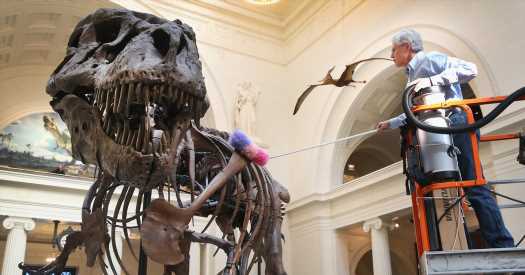Dinosaurs loom large in the human imagination, towering above the treetops, bringing down prey and reigning over the ancient land, sea and sky.
In real life, though, things weren’t always so spectacular. A paper published last week in Philosophical Transactions of the Royal Society B by Les Hearn, a retired science teacher, and Amanda Williams, a psychologist seeking evidence of chronic pain in other species, collects the wince-inducing tales of hundreds of dinosaur injuries. Paleontologists are able to deduce whether dinosaurs suffered wounds during their lifetimes by analyzing fossilized bones and other evidence, and have found a tyrannosaur with its rival’s tooth embedded in its jaw, unusually spaced tracks left by an ornithopod with a toe injury and many more prehistoric owies.
En masse, the injury reports help to demystify the lives of these ancient creatures, which were fraught with danger and, sometimes, slapstick silliness.
They also raise a question: If a banged-up dinosaur walked into a veterinarian’s office today, what might happen next?
Ben Golas, a working veterinarian and a Ph.D. candidate in wildlife disease ecology at Colorado State University, took a break from caring for modern fuzzy and feathered friends to consider how he would treat some damaged dinosaurs if they were brought to his clinic.
At the outset, he said that many dinosaurs showing up at his practice would present logistical issues: “We might have to make the doors a little bit bigger.”
Still, he said, people in his profession train for “the variety that life throws at us,” and the injuries detailed in this recent paper aren’t too far off from those he’s used to treating in other species.
Poor Sue
Before they became the most complete Tyrannosaurus rex ever found, Sue the T. Rex had an exciting time on Earth — one that resulted in several broken arm bones on the right side, along with a number of other injuries.
“If a big dog got hit by a car, we might see this same sort of presentation,” Dr. Golas said.
He recommended temporarily immobilizing the injured right arm by bandaging it against the body. “We would need a lot of vet wrap,” he said.
And they might need a dino-size e-collar or “cone of shame.”
“If Sue could get their head around to lick the wound, they would absolutely need a cone,” he said.
Walking It Off
One ornithopod managed to get around despite a damaged toe pad. Its fossilized footprints showed a limp, which was how paleontologists diagnosed the injury.
Dr. Golas suggested a ball bandage — a thick wad of gauze that the animal can grab onto and is then wrapped around the foot. This is often used to treat birds with claw distress. “It takes some pressure off the painful area,” he said, allowing it to heal.
Out on a Limb
Next, Dr. Golas considered the case of a dilophosaurus — a theropod, or the same dino order as T. Rex — that holds the current record for most injuries found in one forelimb: eight, ranging from a fractured scapula to abscesses on the hand.
“It would be totally reasonable to think that these injuries came from a fight,” he said.
Such a complex set of scrapes calls for a mix of stabilization and antibiotics — as well as a muzzle, often necessary when animals are in pain and want to protect their limbs, Dr. Golas said. If the infection kept raging, amputation might be the best answer, after which “we’d have to find a dilophosaurus rescue center” for the animal to live out its days.
A Landslide Brought Her Down
The next patient was an oviraptor with a fracture of the ulnar bone in her forearm.
Dr. Golas prescribed a “figure-eight” style bandage to keep her forearm still, along with “strict cage rest.”
Although this dinosaur wouldn’t have had bandages available, she seems to have managed the second part of her treatment plan on her own: When she died, likely from a landslide or other accident, she was on nest rest, incubating a clutch of eggs, and her fracture was mostly healed.
Not All Fun and Games
Then there’s the tyrannosaur whose rival broke a tooth off inside its jaw.
A bite to the face is bad enough — when the tooth stays in the wound, things get more dire. “Teeth are basically needles that are injecting tons of gross mouth bacteria underneath the skin,” said Dr. Golas.
“The embedded tooth could quickly become an abscess that might make eating food painful. After removing it, we would want to provide a soft diet until healed,” he said.
A feeding tube might also be necessary. Both seem like humiliating prospects for a bone-crunching carnivore, although perhaps it would find a meat smoothie delicious.
His own lunch break over, Dr. Golas returned to his real-life patients, with a new appreciation for what he would have had to deal with in the days before domestication.-
Source: Read Full Article
